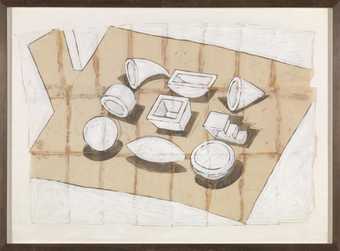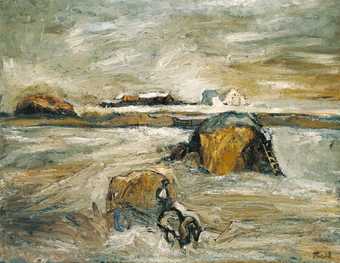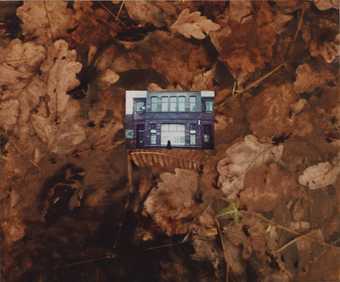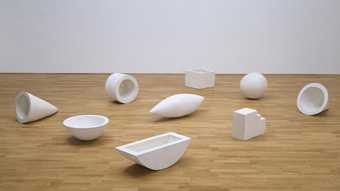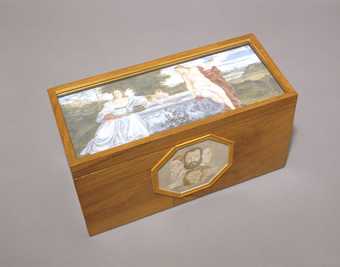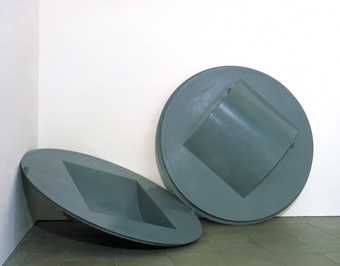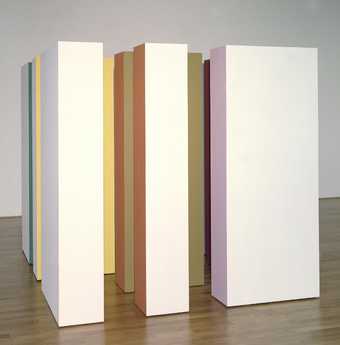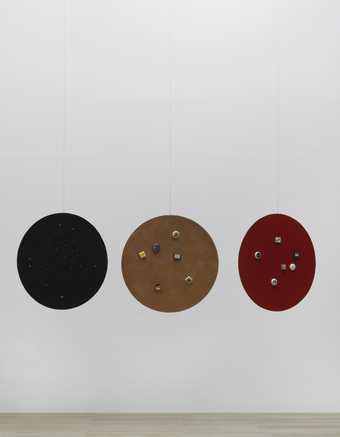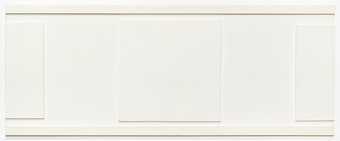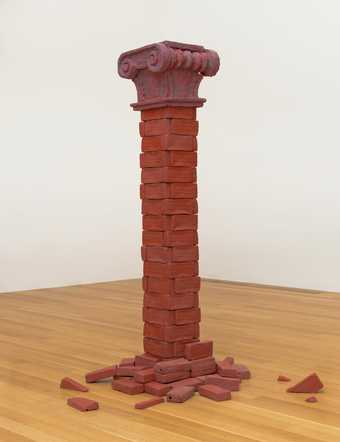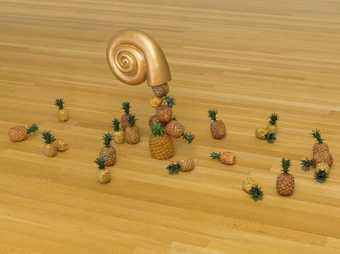
Not on display
- Artist
- Edward Allington 1951–2017
- Medium
- Wood, zinc and paint
- Dimensions
- Object: 1230 × 1383 × 510 mm
- Collection
- Tate
- Acquisition
- Presented by the artist's estate 2020
- Reference
- T15561
Summary
Unsupported Support 1987 is a painted wood sculpture that represents a Classical pilaster capital made up of three Ionic-style ‘S’ curve consoles but with the pilaster’s pier itself removed. Installed high up on a wall but just below the ceiling line, the capital is neither supporting anything (the consoles themselves just support the stepped cornice above it) nor is it supported by the absent pilaster pier, hence the title of the work.
Allington was identified – alongside other British artists such as Bill Woodrow, Tony Cragg and Julian Opie, many of whom, like him, were supported by the Lisson Gallery in London – with the emergence of so-called new image sculpture at the end of the 1970s and in the early 1980s, corresponding with the growing prominence of neo-expressionist, new image painting. Their work was characterised by a use of cheap found materials that connected with a contemporary everyday life. This outlook was based on a collage approach, not only of different and contrasting materials but also including a mix of source imagery or style, ideals and principles; within the field of architecture it was signalled by the AT&T Building on Madison Avenue, New York, of 1978–84 by Philip Johnson (1905–2006) – a modernist office building topped by an open pediment design often identified as close to the cabinet maker Thomas Chippendale (1718–1779).
Allington’s Unsupported Support and the related Architectural Fragment / Third Column 1986 (Tate T15560) follow parallel strategies to those that underlaid Johnson’s buildings, and architectural postmodernism more generally. At the root of Allington’s work is his engagement with a clash of traditions and philosophies between classical forms and ideals and the street, an engagement that questions where philosophical or material truth might be recognised. Allington’s sculpture in the 1980s did not simply involve a straightforward collision of different styles and historical periods but was driven by the urge to communicate what the critic Michael Newman identified as ‘a sense of falsity and loss … framed as the degradation of a Classical heritage.’ (Michael Newman, ‘Discourse and Desire, Recent British Sculpture’, Flash Art, no.115, January 1984, pp.54–5.)
Where Allington’s work of the early 1980s communicated this through Dionysian arrangements of plastic fruit and other fake objects spilling from cornucopia or ‘horns of plenty’ – as seen in the sculpture Oblivion Penetrated 1982 (Tate T06895) – from the mid-1980s onwards he turned to the orders of classical architecture in works which present fragments of architectural motifs removed of built function and isolated out of context to convey a similar slippage between truth and falsehood. The displaced architectural fragments indicate a loss of fixity that in turn provided, for Allington, a touchstone for the present condition, at a time when much philosophical and artistic discourse engaged with the idea of ‘simulation’ – the fake and the real could not be identified as such since, in the words of the theorist Jean Baudrillard, simulation ‘bears no relation to reality whatsoever’ (Jean Baudrillard, Simulations, New York 1983, p.11). From such a perspective as this, Allington was involved in an absurdist re-presentation of classical order to underline what he held to be the ‘cultural paradox of the reality of today’ (Edward Allington, untitled statement, on the invitation card for the exhibition Edward Allington, Lisson Gallery, London 1984.)
Unsupported Support was included in the exhibition Edward Allington: Things Unsaid, a retrospective survey of the artist’s work held at the Henry Moore Institute, Leeds from October 2019 to February 2020.
Further reading
Edward Allington, In Pursuit of Savage Luxury, exhibition catalogue, Midland Group Nottingham 1984.
Edward Allington: New Sculpture, exhibition catalogue, Riverside Studios, London 1985.
Edward Allington, exhibition catalogue, Cornerhouse, Manchester 1993.
Andrew Wilson
October 2019
Does this text contain inaccurate information or language that you feel we should improve or change? We would like to hear from you.
Display caption
Unsupported Support is a pilaster capital – the top section of a classical column. Removed from its column, it is mounted high on the wall, just below the ceiling line. As the title suggests, it does not support anything, nor is it supported by anything.Allington’s recreations of classical architecture are purposely absurd. They reflect his concern with truth and simulation. These ideas were explored by many artists and philosophers in the 1980s.
Gallery label, October 2020
Does this text contain inaccurate information or language that you feel we should improve or change? We would like to hear from you.
You might like
-
Edward Allington Ideal Standard Forms
1981 -
Sheila Fell Haystack in a Field
1967 -
Conrad Atkinson For Wordsworth; for West Cumbria
1980 -
Edward Allington Ideal Standard Forms
1980 -
John Lessore Allegorical Box
1976 -
Grenville Davey By Air
1989 -
Julian Opie It Is Believed That Some Dinosaurs Could Run Faster Than a Cheetah
1991 -
Li Yuan-chia Hanging Disc Toy
c.1980 -
Li Yuan-chia 0 1=2
1965 -
Edward Allington Architectural Fragment / Third column
1986 -
Edward Allington From the Birth of Paradise
1983

